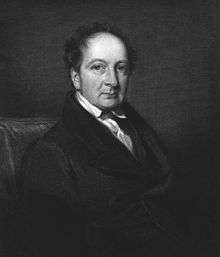John Cheyne (physician)
Dr John Cheyne FRSE FKQCPI (3 February 1777 – 31 January 1836) was a British physician, surgeon, Professor of Medicine in the Royal College of Surgery in Ireland (RCSI) and author of monographs on a number of medical topics. He was one of the people to identify Cheyne–Stokes respiration.
John Cheyne | |
|---|---|
 | |
| Born | 3 February 1777 |
| Died | 31 January 1836 (aged 58) |
| Alma mater | Edinburgh University |
| Known for | Cheyne–Stokes respiration |
| Scientific career | |
| Fields | medicine |
Life
He was born in Leith, the son of Dr John Cheyne, a surgeon.[1] The family lived at New Key (Quay) in the middle of the Shore.[2] He was educated at Leith Grammar School and then the High School in Edinburgh.[3]
Having grown up around medical practice, he was able to enter Edinburgh University at the age of 15, graduating as a doctor at 18 years of age. He joined the army, worked as a surgeon with an artillery corps, and was present at the Battle of Vinegar Hill. Cheyne rejoined his father's practice four years later in 1799.
Ten years later, Cheyne moved to Dublin and in 1811 began working at the Meath Hospital. He was appointed Professor of Medicine in the Royal College of Surgery in Ireland (RCSI) in 1813. In 1814 he was elected to the Royal Society of Edinburgh. He also taught war medicine and was appointed Physician General to British forces in Ireland in 1820. He gained the Fellowship of the King and Queen's College of Physicians of Ireland in 1824.[4] He retired to England in 1831 following a course of ill health, and died at his country estate at Sherington, Buckinghamshire on 31 January 1836.[3]
Cheyne wrote a number of books, including Essays of Diseases of Children in 1801. He was also the author of an early treatise on the larynx in 1809, Pathology of the Membrane of the Larynx and Bronchia.
With Francis Barker, he published a two-volume work on fever epidemics in Ireland, in 1821.[5]
Publications
- Essays on the Diseases of Children: With Cases and Dissections (1802)
- The Pathology of the Membrane of the Larynx and Bronchia (1809)
- Cases of Apoplexy and Lethargy: With Observations Upon the Comatose Diseases (1812)
- Essays on Partial Derangement of the Mind in Supposed Connexion with Religion (1843)
References
- Doyle, D (December 2006). "Eponymous doctors associated with Edinburgh, Part 2--David Bruce, John Cheyne, William Stokes, Alexander Monro Secundus, Joseph Gamgee". The Journal of the Royal College of Physicians of Edinburgh. 36 (4): 374–81. PMID 17526135.
- Pearce, J M S (May 2002). "Cheyne–Stokes respiration". J. Neurol. Neurosurg. Psychiatry. 72 (5): 595. doi:10.1136/jnnp.72.5.595. PMC 1737878. PMID 11971044.
- Tollis, D (1995). "Who were ... Cheyne and Stokes?". Nursing times. 91 (14): 40. PMID 7731827.
- Lyons, J B (March 1995). "John Cheyne's classic monographs". Journal of the History of the Neurosciences. 4 (1): 27–35. doi:10.1080/09647049509525624. PMID 11619012.
- Sternbach, G L (1985). "John Cheyne and William Stokes: periodic respiration". The Journal of Emergency Medicine. 3 (3): 233–6. doi:10.1016/0736-4679(85)90078-2. PMID 3912428.
- Bendiner, E (June 1984). "The Dublin school: from poverty, a rich legacy". Hosp. Pract. (Off. Ed.). 19 (6): 221–47. PMID 6427248.
Notes
- Edinburgh and Leith Post Office Directory 1773
- https://archive.org/stream/directoryforedin17941795aitc#page/196/mode/2up
- "Former Fellows of The Royal Society of Edinburgh, 1783–2002, Part 1" (PDF). The Royal Society of Edinburgh. 2006. p. 178. Retrieved 21 January 2020.
- Lyons, JB (1999). A Pride of Professors, the Professors of Medicine at the Royal College of Surgeons in Ireland 1813-1885. Dublin: Farmar. pp. 11–46. ISBN 1899047514.
- Geary, Laurence M. "Barker, Francis". Oxford Dictionary of National Biography (online ed.). Oxford University Press. doi:10.1093/ref:odnb/1394. (Subscription or UK public library membership required.)
External links
- John Cheyne - at Who named it?